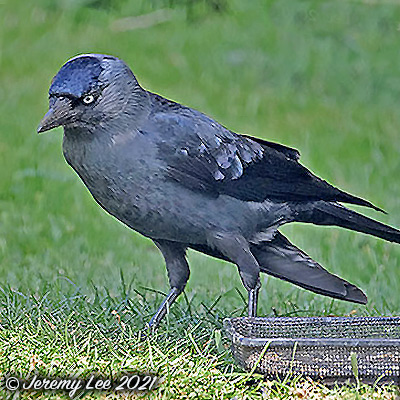
 |
|
Scientific Classifications explained » Amphibians » Ants » Aphids » Bees » Beetles » Birds » Bugs » Butterflies » Caterpillars » Damselflies » Dragonflies » Earwigs » Flies » Frog/Leafhoppers » Fungi » Galls » Grasshoppers » Harvestmen » Hoverflies » Lacewings » Ladybirds » Leaf Mines » Lichens » Mammals » Millipedes » Mosses » Moths » Sawflies » Slugs » Snails » Spiders » Trees & Shrubs » Wasps » Wild Flowers » Woodlice » Postboxes |
UK Nature > Birds > Corvus monedula

Scientific Name: Corvus monedula Common Name: Jackdaw Corvus monedula, more commonly known as the Jackdaw, are roughly 30cm in length. They have glossy black plumage with an obvious grey nape and beady little white eyes; both sexes are alike. Quite varied in its feeding habits: insects and their larvae, grain, weed seeds, wild and cultivated fruit; sometimes small animals, eggs and young of other birds; potatoes and carrion. For the nest, both sexes make an untidy pile of sticks, lined with wool and hair, nearly always in a hole or crevice in a tree, cliff or building. Jackdaws can be found in fields, woods, parks and gardens. They're social birds and roost communally in woodlands. They can be seen at any time of year. Jackdaws often join up with rooks and carrion crows in autumn and winter to roost together in huge numbers. They're widespread and common across the UK, with the exception of the Scottish Highlands. |
|

https://www.uknature.co.uk is a website dedicated to showing the immense diversity of UK nature and wildlife. Our vast range of habitats, from lowland arable to snow covered mountains, from storm-ravaged coastlines to peaceful inland freshwater lakes and rivers, from dry, sandy heaths to deciduous and coniferous forests, all these habitats contribute to the abundance of UK nature. We have wild birds in huge numbers either residing or visiting our shores (597 recorded species as at July 2013) and we must also not forget the humble back garden with its grass lawns, flower beds filled with nectar rich flowers, shrubs and trees, all designed to attract huge numbers of insects such as bees, moths, butterflies and hoverflies; and finally the small ponds which provide safe havens for frogs, toads, newts and even slow worms and grass snakes. www.uknature.co.uk is the showcase for my personal passion, photographing uknature in all its glory. I sincerely hope you all enjoy the fruits of my labours. This site and all images contained therein is © Jeremy Lee 2004 - 2025. All Rights Reserved. Site design by Jeremy Lee. Site development & IT Support by Stuart Lee. |